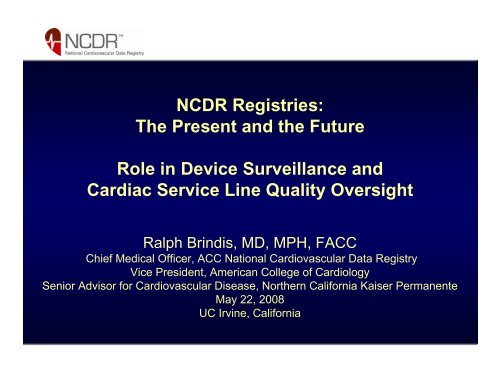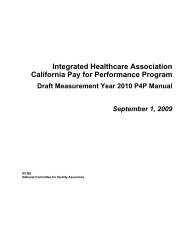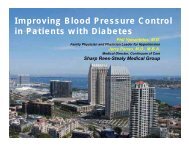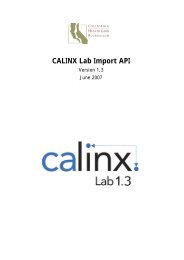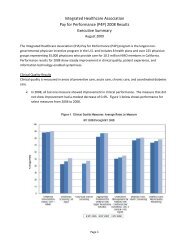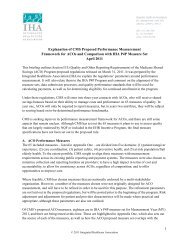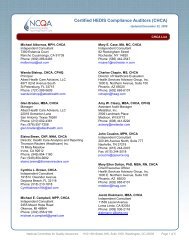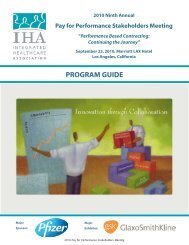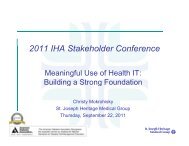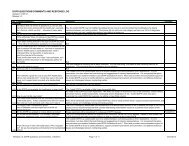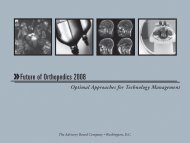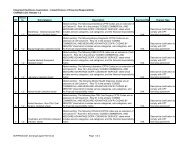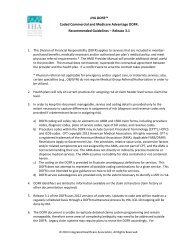NCDR Registries - Integrated Healthcare Association
NCDR Registries - Integrated Healthcare Association
NCDR Registries - Integrated Healthcare Association
Create successful ePaper yourself
Turn your PDF publications into a flip-book with our unique Google optimized e-Paper software.
<strong>NCDR</strong> <strong>Registries</strong>:<br />
The Present and the Future<br />
Role in Device Surveillance and<br />
Cardiac Service Line Quality Oversight<br />
Ralph Brindis, MD, MPH, FACC<br />
Chief Medical Officer, ACC National Cardiovascular Data Registry<br />
Vice President, American College of Cardiology<br />
Senior Advisor for Cardiovascular Disease, Northern California Kaiser Permanente<br />
May 22, 2008<br />
UC Irvine, California
National Cardiovascular Data Registry<br />
Imaging<br />
Registry<br />
Timeline and growth…<br />
ICD Long<br />
IMPACT<br />
Registry<br />
EP<br />
Registry<br />
IC3-Office<br />
PAD<br />
Registry<br />
CathPCI<br />
Registry<br />
ICD<br />
Registry<br />
CARE<br />
Registry<br />
ACTION<br />
Registry<br />
HF<br />
Registry<br />
1998….. 2004 2005 2006 2007 2008 beyond
What is the National Cardiovascular Data Registry?<br />
<strong>Registries</strong><br />
Analytic<br />
Reporting Services<br />
WellPoint CMS BCBSA<br />
CathPCI<br />
IMPACT<br />
WVMI<br />
United<br />
BMC2<br />
Aetna<br />
ICD<br />
IC3<br />
HCA<br />
Research<br />
& Publication Services<br />
CARE<br />
FDA<br />
Yale<br />
ACC<br />
ACTION<br />
Industry<br />
DCRI<br />
MAHI<br />
Ad hoc<br />
Registry Studies<br />
Quality Improvement<br />
TAKE ACTION<br />
SPECT MPI<br />
QI KIT<br />
ICD Long.<br />
Field Base Consultants
Committee Structure and Project Summary<br />
<strong>NCDR</strong> Management Board<br />
Scientific Oversight Committee<br />
Data Monitoring Board<br />
Committee Structure for<br />
each Registry<br />
Steering<br />
Committee<br />
<strong>Registries</strong><br />
Registry Projects<br />
QI Projects<br />
Clinical Supp.Team<br />
Research &<br />
Publications<br />
ACTION<br />
Registry<br />
ambulatory<br />
IC3<br />
Steering Committee<br />
TAKE ACTION<br />
Planning Work Group<br />
CathPCI<br />
Registry<br />
longitudinal<br />
ACHIEVE<br />
Steering Committee<br />
D2B<br />
Project managed through<br />
ACTION and PCI Steering<br />
committees<br />
ICD<br />
Registry<br />
longitudinal<br />
ICD Longit.<br />
Steering Committee<br />
CARE<br />
Registry<br />
Includes 30day<br />
outcomes<br />
Over 130 of our nation’s<br />
CV Outcomes experts involved
<strong>NCDR</strong> Founding Father<br />
Bill Weintraub
“Science tells us what we can do;<br />
Guidelines what we should do;<br />
<strong>Registries</strong> what we are actually doing.”
The Cycle of Clinical<br />
Therapeutic Effectiveness<br />
Concept<br />
Clinical<br />
Trials<br />
Guidelines<br />
<strong>NCDR</strong>:<br />
ACTION<br />
Cath PCI<br />
& STS<br />
Outcomes<br />
QUALITY<br />
Performance<br />
Performance<br />
Indicators
Uses of Registry Data<br />
• Quality Improvement<br />
• Research/Clinical Practice Guidelines<br />
• Post-Market Surveillance<br />
• Informed Decision Making in Real Time<br />
• Maintenance of Certification & Privileging<br />
• Meet Regulatory Needs<br />
• Pay for Participation, Reporting, and Performance<br />
• Utilization Data and Metrics
Registry/QI<br />
• 1000 hospitals<br />
• >6 million patient records<br />
• Online data entry tool<br />
• Support D2B Alliance<br />
ARS<br />
• States – MA, OH, WV,<br />
?CT, ?NJ, ?CA<br />
• Payers – United, BCBSA,<br />
WellPoint<br />
Research and Publications<br />
• DCRI analytic center<br />
• Over 100 publications<br />
Facilities<br />
1000<br />
900<br />
800<br />
700<br />
600<br />
500<br />
400<br />
300<br />
200<br />
100<br />
0<br />
CathPCI Registry Enrollment<br />
825<br />
658<br />
547<br />
472<br />
362<br />
321<br />
272<br />
190<br />
1000<br />
1999 2000 2001 2002 2003 2004 2005 2006 2007F<br />
Participants
CON/Legislative Mandate<br />
• Massachusetts Department of Health<br />
• West Virginia Health Care Authority<br />
• Michigan Department of Community Health<br />
• New Jersey Department of Health
States Considering<br />
CathPCI Registry Adoption<br />
• Maryland Health Care Commission<br />
• California<br />
– Health care reform legislation<br />
• OSHPD desire following success of CABG program<br />
– Elective PCI Pilot Programs<br />
– Counties creating STEMI coordinating center models<br />
• Washington State Department of Health
Analytic and Reporting Services<br />
• Blue Cross Blue Shield <strong>Association</strong><br />
• HCA Mountain Star Division<br />
• United <strong>Healthcare</strong><br />
• WellPoint (Q-HIP, QP3, and CSC programs)<br />
• West Virginia Medical Institute (for WV and PA<br />
mandates)
Acute Coronary Syndromes<br />
Registry<br />
• 325 participants<br />
• Over 55,000 records<br />
• No charge<br />
• Funding provided by<br />
– Genentech<br />
– Bristol-Myers<br />
Squibb/Sanofi Partnership<br />
– Schering Plough<br />
Corporation<br />
AHA GWTG-CAD Merger to ACTION 2009
Purpose of the ACTION Registry<br />
• A national surveillance system<br />
– Assess characteristics, treatments, and outcomes of patients<br />
hospitalized with ACS<br />
– Focusing on high risk patients with STEMI and NSTEMI<br />
• Optimize outcomes and management of ACS patients<br />
– Implement evidence-based guideline recommendations in<br />
clinical practice<br />
• Facilitate efforts to improve quality & safety of ACS care<br />
• Investigate novel quality improvement methods
The CARE Registry ®<br />
A hospital-wide data collection tool for all carotid<br />
revascularization procedures:<br />
Carotid artery stent (CAS)<br />
Carotid endarterectomy (CEA)<br />
Objectively elements of care for both CAS or CEA<br />
Meets reimbursement requirements for CMS<br />
Provides national benchmarks for quality<br />
improvement
Benefits of Enrolling with<br />
CARE Registry ®<br />
• Proven track record<br />
• National in scope<br />
• Applies to both carotid surgery and stenting<br />
• Receive quarterly benchmarking information<br />
– Patient specific<br />
– Provider specific<br />
– Institution specific<br />
• Free online data collection tool<br />
• Online data submission
How Do Clinical <strong>Registries</strong> Impact Practice?<br />
1. How do I, or my facility, measure up?<br />
(a.k.a. benchmarking)<br />
2. <strong>Registries</strong> are a resource to answer<br />
practical “real world” questions that<br />
impact your everyday practice.<br />
3. <strong>Registries</strong> are tool to help you and your<br />
facility improve.
The <strong>NCDR</strong> Dashboard Report
Advantages of a Registry<br />
• Standard data definitions (comparing apples to apples)<br />
• Data audit program - An <strong>NCDR</strong> feature<br />
• Provides data that are<br />
– Relevant, Credible, Timely, Actionable<br />
• Help facilities meet consumer, payer, and<br />
regulator demands for reporting and quality care<br />
• Counts for ABIM maintenance of certification<br />
It’s All About Improving QUALITY!
How Do Clinical <strong>Registries</strong> Impact My<br />
Practice?<br />
1. How do I, or my facility, measure up?<br />
(a.k.a. benchmarking)<br />
2. <strong>Registries</strong> are a resource to answer<br />
practical “real world” questions that<br />
impact your everyday practice.<br />
3. <strong>Registries</strong> are tool to help you and your<br />
facility improve.
Answers Important Questions: Are we doing better?<br />
Percentage of Primary PCI with D2B
Risk of Local Adverse Effects<br />
Following Cardiac Catheterization<br />
by Hemostasis Device and Gender<br />
A Report from the <strong>NCDR</strong> in<br />
Partnership with the FDA<br />
Dale Tavris, Syamal Dey, Albrecht Gallauresi, Richard Shaw,<br />
William Weintraub, Kristi Mitchell, Ralph Brindis<br />
Grant from Office of Women’s Health, Food and Drug Administration
<strong>Registries</strong> as a Data Resource<br />
• Other questions addressed by <strong>NCDR</strong> data<br />
– DES/BMS utilization rates & stents/procedure<br />
– Hospital volume and PCI mortality<br />
– PCI outcome in patients > 85 years<br />
– Safety of PCI without on-site surgical<br />
backup<br />
• Future questions to be addresses<br />
– Optimal duration of clopidogrel (prasugrel)<br />
• CODA- and 3P CODA-DES<br />
– AHRQ/FDA Long-term Outcome of<br />
Coronary Stents Study
Trends in DES vs. BMS Use for PCI for NSTEMI<br />
%<br />
100<br />
90<br />
80<br />
70<br />
60<br />
50<br />
DES Debate Begins<br />
40<br />
30<br />
FDA Advisory Panel<br />
DES<br />
BMS<br />
20<br />
10<br />
0<br />
Q1 06 Q2 06 Q3 06 Q4 06 Q1 07 Q2 07 Q3 07 Q4 07
Hospital PCI Volume and In-Hospital Mortality<br />
ACC-<strong>NCDR</strong>® 2001-2004<br />
Hospital PCI<br />
Volume (pts)<br />
STEMI Non-STEMI Elective<br />
n=90,256 pts n=94,587 pts n=482,960 pts<br />
≤200 vs >800 0.99 (0.75,1.31) 0.64 (0.38,1.06) 1.17 (0.81,1.71)<br />
201-400 vs >800 0.96 (0.83,1.12) 0.87 (0.68, 1.10) 1.12 (0.96, 1.31)<br />
401-800 vs >800 0.95 (0.85,1.07) 0.96 (0.81,1.14) 1.10 (0.99,1.22)<br />
Mortality 4.83% 2.09% 0.41%<br />
Zhang et al Circulation 2005 Suppl II;112:792.<br />
(Odds Ratio, 95% CI)
PCI without Surgery On Site<br />
Percutaneous Coronary Interventions<br />
in Facilities<br />
without On-Site Cardiac Surgery:<br />
A Report from the National<br />
Cardiovascular Data Registry (<strong>NCDR</strong>)<br />
ACC/SCAI – i2 Summit<br />
Late Breaking Clinical Trials<br />
March 29, 2008
PCI without Surgery On Site<br />
Study Population<br />
<strong>NCDR</strong> CathPCI Registry<br />
Consecutive PCI cases<br />
January 1, 2004 to March 30, 2006<br />
308,161 patients<br />
465 centers<br />
OFF-SITE Surgery Back-Up<br />
9,029 patients<br />
61 centers<br />
ON-SITE Surgery Back-up<br />
299,132 patients<br />
404 centers
Risk Adjusted Outcomes<br />
Odds Ratio (OR): outcomes for patients at On-Site (vs. Off-Site) facilities<br />
adjusting for site correlations and potential confounding variables
PCI without Surgery On Site<br />
Conclusions<br />
• Off-Site PCI centers participating in the <strong>NCDR</strong><br />
are well organized with good logistical plans:<br />
‣ Dedicated staff and facilities.<br />
‣ Travel time, distances, and modality of transport are<br />
appropriate for timely transfer to the off-site surgery<br />
center.<br />
‣ 92% provide 24/7 coverage.<br />
‣ All sites are committed to provide primary PCI for<br />
STEMI.
PCI without Surgery On Site<br />
Conclusions<br />
• Compared to On-Site PCI centers, Off-Site PCI<br />
programs participating in the <strong>NCDR</strong>:<br />
‣ Have smaller bed capacities.<br />
‣ Are predominantly located in rural and suburban areas.<br />
‣ Have lower annual PCI volume.<br />
‣ Treat a higher percentage of patients who present with<br />
subsets of MI (STEMI and NSTEMI).<br />
‣ Have better reperfusion times in primary PCI.
Conclusions<br />
• Compared to On-Site PCI centers, Off-Site PCI<br />
programs have similar observed:<br />
‣ Procedure success<br />
‣ Morbidity<br />
‣ Emergency surgery rates<br />
‣ Mortality in cases that require emergency surgery<br />
• The risk-adjusted mortality rate in Off-Site<br />
facilities was comparable to those PCI centers<br />
that have cardiac surgery on-site.
Implications<br />
• The safety and effectiveness of Off-Site PCI<br />
programs is a very important issue which<br />
requires ongoing evidence-based assessment.<br />
• The results of this study should not be used to<br />
encourage the expansion of more Off-Site PCI<br />
programs, rather it should confirm the<br />
appropriateness of an Off-Site strategy for<br />
programs that have made a commitment to<br />
excellence in organization and logistics.
The Future is Now !!<br />
CODA<br />
Clopidogrel Optimal Duration Dual Anti-Platelet<br />
Therapy- and 3-arm Prasugrel Clopidogrel Optimal<br />
Duration Anti-Platelet Therapy after DES<br />
Study Goal<br />
Examine the role of dual Clopidogrel & aspirin and,<br />
possibly, the role of Prasugrel & aspirin antiplatelet<br />
therapy as a class effect across all DES platforms.<br />
- <strong>NCDR</strong> Patient Recruitment Strategy
•DES & Extended Dual Antiplatelet Therapy:<br />
What It Would Take: Collaboration: CODA-DES<br />
• Regulatory<br />
• FDA:<br />
– CDER<br />
– CDRH<br />
– Off Comm<br />
• E.U.<br />
– Austria<br />
– U.K.<br />
– Sweden<br />
• MHLW/PMDA<br />
• Japan<br />
• Academia<br />
• Industry<br />
• Duke<br />
• BSCI<br />
• Harvard<br />
• Medtronic<br />
• Cleveland •<strong>NCDR</strong><br />
• Abbott<br />
Clinic<br />
•<br />
•Hospitals,<br />
Cordis/J&J<br />
• Columbia<br />
• Eli Lilly<br />
• U of NM<br />
(Daichi)<br />
• Wash Hrt Ctr<br />
• Sanofi<br />
• London School<br />
• BMS<br />
of Hyg & Trop<br />
Med<br />
• CVPath<br />
•Physicians and Patientss<br />
• Societies<br />
• ACC<br />
• SCAI<br />
• ESC<br />
• Federal<br />
• NIH<br />
• AHRQ
AHRQ- DEcIDE Collaborative with DCRI<br />
• Goals<br />
– Describe temporal trends of DES/BMS<br />
– Analyze downstream DES/BMS patient outcomes<br />
• readmissions, MI’s, repeat revascularizations, and death<br />
• Role of DAT- length of use post implantation<br />
– Create conceptual model of stent decision making<br />
– Feedback to clinicians-outcomes, workshops,<br />
publications, education tools, etc
How Do Clinical <strong>Registries</strong> Impact My<br />
Practice?<br />
1. How do I, or my facility, measure up?<br />
(a.k.a. benchmarking)<br />
2. <strong>Registries</strong> are a resource to answer<br />
practical “real world” questions that<br />
impact your everyday practice.<br />
3. <strong>Registries</strong> are tool to help you and your<br />
facility improve.
Benchmarking: Primary PCI %
What Are Our Opportunities for Improvement?<br />
Your hospital vs. the nation
The Future is Now<br />
• Episodic in-Hospital <strong>Registries</strong><br />
– Assess In-hospital procedural complications/outcomes<br />
TO:<br />
• Longitudinal <strong>Registries</strong> allowing:<br />
– Evaluation of clinical outcomes long-term<br />
– Develop “disease oriented” <strong>Registries</strong> through linkage<br />
with relevant <strong>Registries</strong><br />
– Outcomes assessments by varying treatment<br />
strategies<br />
– Ability for post-market device and drug surveillance
CMS- Yale- <strong>NCDR</strong>- ACC<br />
Public Performance Measure Development<br />
• Initial effort - <strong>NCDR</strong> CathPCI outcomes measures<br />
– 30 day mortality following PCI<br />
– 30 day readmission following PCI<br />
• Linkage with CMS claims data for 30 day<br />
longitudinal assessment<br />
– Probabilistic Matching –unique patient admission by<br />
hospital, admission date, age, gender<br />
– HIPAA Compliant
<strong>NCDR</strong> Data Merging Partnerships<br />
• Society of Thoracic Surgery<br />
– Opportunity to merge PCI and CABG Databases !!!<br />
– Better understanding practice patterns and longitudinal<br />
outcomes<br />
– Cross match patients with CMS data<br />
– Cross match patients with Health Plans<br />
• Wellpoint, Aetna, BCBS, United<strong>Healthcare</strong>:<br />
– Hospital, longitudinal, and pharmacy data<br />
– Funded Longitudinal projects- Symptoms/QAL via SAQ
Six-Fold Geographic Variations in Age-Adjusted Coronary<br />
Interventional Procedure Rates<br />
Redding<br />
Median = 8 / 1000<br />
Range = 3 - 20<br />
Wennberg, D. The Dartmouth Atlas of Cardiovascular Health Care 1999
64 Slice<br />
Coronary CT
APPROPRIATENESS CRITERIA<br />
• SPECT-MPI<br />
• CCT/MRI<br />
• TTE/TEEchocardiography<br />
• Stress Echocardiography Fall 2007<br />
• Coronary Revasc: PCI/CABG – Summer 2008<br />
• Implementation of AC Pilot(s) Spring 2008<br />
• CV imaging Cross Modality Appropriateness 2008
Future Challenges for National <strong>Registries</strong><br />
• Use of <strong>Registries</strong> for:<br />
Public Reporting & Physician-level Reporting<br />
– Validity of the Performance Measure reported<br />
• Risk of the use other important but not “valid”<br />
performance metrics or utilization data<br />
– Accuracy<br />
– Transparency<br />
– Attribution<br />
– Minimize negative unintended consequences
Future Challenges for National <strong>Registries</strong><br />
• Use of <strong>Registries</strong> for:<br />
Public Reporting & Physician-level Reporting<br />
We need systematic change designed to engage<br />
physicians and track scientific and meaningful<br />
measures:<br />
1. Pay for Participation<br />
2. Test the Performance Measures<br />
3. Baseline Reporting<br />
4. Valid Performance Measurement
Future Challenges for National <strong>Registries</strong><br />
• Achieve data standardization<br />
• Streamline data collection-100% EHR integration<br />
• Unique Patient identifier – Legislative Approach<br />
• Linkage of relevant <strong>Registries</strong><br />
• Longitudinal strategies – develop viable business<br />
cases<br />
• GOAL: Convert procedural or episodic<br />
hospital based <strong>Registries</strong> to “disease state”<br />
patient-centric registries
Can’t wait to stop wearing these<br />
red dresses once<br />
George’s Presidency is over !!<br />
Love that<br />
new CV<br />
Technology!<br />
I thought<br />
I was going to meet<br />
Obama !


